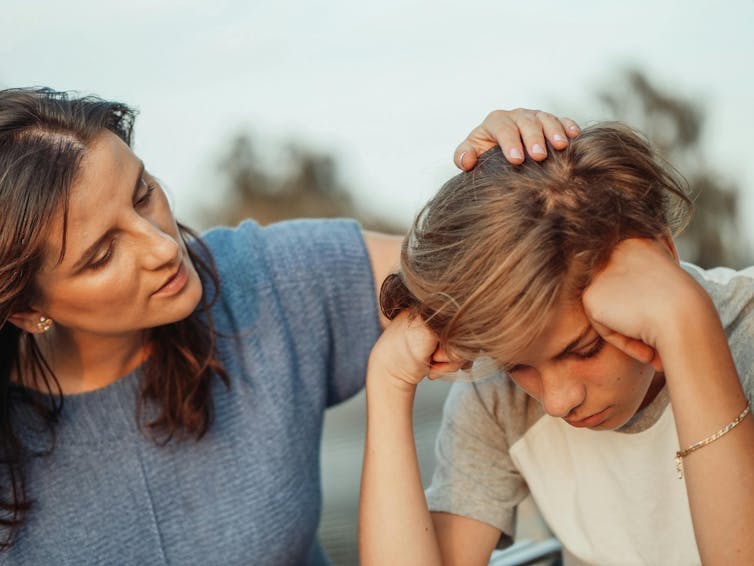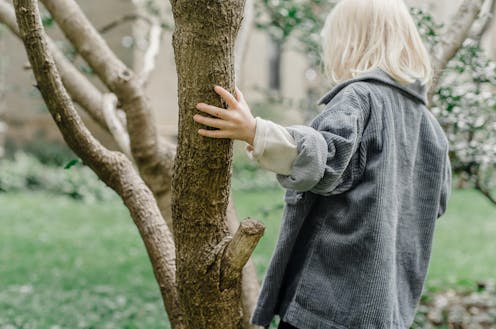Source: The Conversation (Au and NZ) – By Gemma Sicouri, Senior Postdoctoral Research Fellow and Clinical Psychologist, Black Dog Institute, UNSW Sydney
In the movie Inside Out 2, 13-year-old Riley, who has recently started puberty, has a panic attack during a hockey game timeout.
Anxiety (the emotion responsible for the panic attack) becomes completely frenzied and there is a sense Riley is losing control. After a while, Anxiety calms down and Riley’s panic attack subsides.
The movie does a great job of conveying the experience of having a panic attack. But panic attacks (and anxiety) don’t just arise in teenagers – younger children can also have them.
Being aware of what to look out for and how to respond to anxiety or panic is important to help you and your child better manage these scary symptoms.
What does a panic attack look like in a child?

Rivelino/Pexels
A panic attack is a sudden, intense feeling of fear or discomfort associated with four or more of the following:
- feeling very hot or cold
- racing heart
- shortness of breath
- tightness in the throat or chest
- sweating
- tingling sensations
- light-headedness.
Panic attacks in children can last from a few minutes to 30 minutes.
Some children describe a panic attack as feeling like they are trapped or in danger, that something terrible is happening to them, they are losing control of their body, having a heart attack, or even dying.
Often, a child is unaware their symptoms are related to anxiety. This experience can be very scary for children and others around them who don’t know what is happening.
How common are panic attacks and at what age might they start?
There is a common myth that panic attacks only occur in teenagers or adults, but research shows this is not the case.
Although less frequent than in teenagers, panic attacks also occur in children. Studies indicate around 3–5% of children experience panic attacks.
They can begin at any age, although they typically first occur in children and adolescents between the ages of five and 18.
What causes a panic attack?
For some children, panic attacks can happen unexpectedly and without cause. These are known as “uncued” panic attacks.
For other children, panic attacks may be cued. This means they occur in specific situations that are anxiety-provoking, such as separating from a caregiver or doing a speech in class.
Cued panic attacks tend to be more common in children than uncued panic attacks.
Sometimes a panic attack can occur when a child’s physical symptoms (from feeling anxious) become the centre of their attention. For example, if a child notices a physical symptom (such as shortness of breath) and becomes worried about it, this can make them feel anxious, leading to more anxiety or a panic attack.
If children realise their physical symptoms are signs of anxiety and not a serious physical health problem, they might learn to not give too much attention to these symptoms and stop a vicious cycle occurring.
What can parents do in the moment to support their child?
If your child is breathing very quickly or hyperventilating, try to remain calm and encourage them to breathe normally.
Tell your child these feelings are temporary and not dangerous. Focusing your child’s attention on their rapid breathing or other symptoms can sometimes make things worse.
Try to help your child focus on something else, using the 3-3-3 rule: “Tell me three things you can hear, three things you can see, and three things you can touch”. Ask them to say these out loud.

Kindel Media/Pexels
If your child complains about bodily symptoms – but is not experiencing a full-blown panic attack – try to understand and acknowledge the symptoms they are experiencing.
Once you are satisfied their symptoms are not a physical health problem, tell them it will be okay and then move on to something else. This will help to shift their attention to something else and stop the anxiety and symptoms from escalating.
What about afterwards?
When your child’s panic attack is over, you can teach them about panic attacks. Explain that panic attacks are common and aren’t dangerous, even though they can feel scary and uncomfortable, and are a temporary sensation.
An effective strategy for panic attacks is a technique from cognitive behavioural therapy called “exposure”, which encourages children to face their fears. For panic attacks, this could be facing certain situations or objects that trigger the panic attack, or exposure to the actual physical symptoms.
Exposure is typically done with the support of a therapist, but increasingly there are programs available which support parents to deliver exposure-based treatment with their child.
Does having a panic attack mean my child has an anxiety disorder?
If your child has a panic attack, it does not mean they have an anxiety disorder. Panic attacks can occur in all children with or without anxiety disorders or mental health conditions.
However, panic attacks often occur in children with anxiety disorders or other mental disorders, such as depression or post-traumatic stress disorder.
Panic disorder is a particular type of anxiety disorder in which panic attacks are a core feature. Panic disorder is not common in children, and occurs in less than 1% pre-adolescent children. It typically emerges in adolescence or adulthood.
If your child is having panic attacks often and unexpectedly, has persistent worry (for at least a month) about additional panic attacks, or avoids situations that may trigger panic attacks, it may indicate they have panic disorder.
If your child is having panic attacks in response to specific situations or fears, such as separating from a caregiver, and their fears are interfering in everyday life, it may indicate an anxiety disorder.
Where can I look for help?
If you are concerned your child has an anxiety disorder, speak to your GP or a psychologist about it.
You don’t need a GP referral to see a psychologist, but a GP can create a mental health treatment plan which allows you to claim a Medicare rebate for up to ten sessions.
There are also a range of online resources.
![]()
Gemma Sicouri receives funding from Australian Rotary Health.
Jennie Hudson works for the Black Dog Institute and receives or has received funding from the National Health and Medical Research, the Australian Research Council, Welcome Trust, Australian Rotary Health, Beyond Blue, the Johnston Foundation and the AMP Foundation.
Annabel Songco and Chloe Lim do not work for, consult, own shares in or receive funding from any company or organisation that would benefit from this article, and have disclosed no relevant affiliations beyond their academic appointment.
– ref. I think my child is having panic attacks. What should we do? – https://theconversation.com/i-think-my-child-is-having-panic-attacks-what-should-we-do-237761










